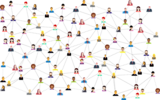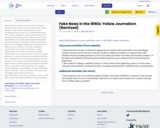
Infographic on the methods of communication that can be utilized through computing systems and networks.
- Subject:
- Networking and the Internet
- Material Type:
- Visual Media
- Author:
- Jude Raffeinner
- Date Added:
- 05/11/2022

Infographic on the methods of communication that can be utilized through computing systems and networks.

Alternative facts, fake news, and post-truth have become common terms in the contemporary news industry. Today, social media platforms allow sensational news to “go viral,” crowdsourced news from ordinary people to compete with professional reporting, and public figures in offices as high as the US presidency to bypass established media outlets when sharing news. However, dramatic reporting in daily news coverage predates the smartphone and tablet by over a century. In the late nineteenth century, the news media war between Joseph Pulitzer’s New York World and William Randolph Hearst’s New York Journal resulted in the rise of yellow journalism, as each newspaper used sensationalism and manipulated facts to increase sales and attract readers.
This is a remix of a previous source. The link to original source is https://goopenva.org/courses/fake-news-in-the-1890s-yellow-journalism
The original author is Melissa Jacobs
Melissa Jacobs, (2018) Fake News in the 1890s: Yellow Journalism. Retrieved from the Digital Public Library of America, https://dp.la/primary-source-sets/fake-news-in-the-1890s-yellow-journalism/additional-resources#tabs

These infographics were made for spreading awareness and education on digital citizenship and internet safety topics. A few included are translated into Spanish. Share on your newsletter, social media or more.

Have your students create their profile either online or by hand. These profiles can be used to help decorate a bulletin board or just done for fun.

Create a fake social media page for a teacher in Spanish that students will then learn how to protect their information through playing an online simulation game.

English Instructional Plan – Social Media in the Workplace